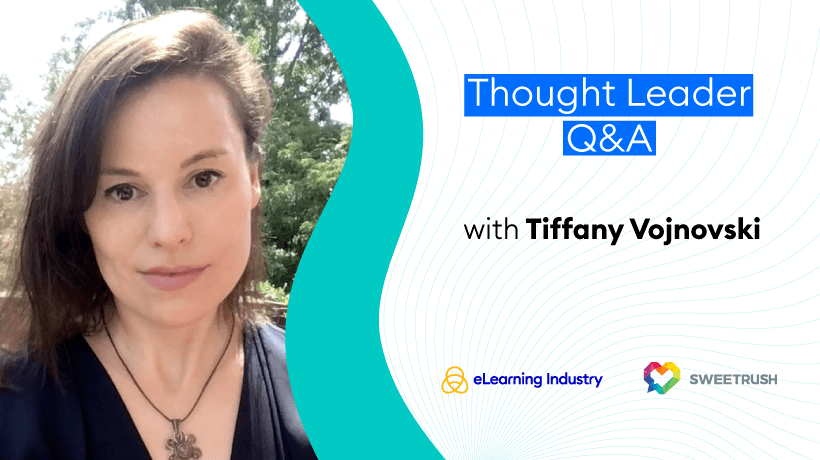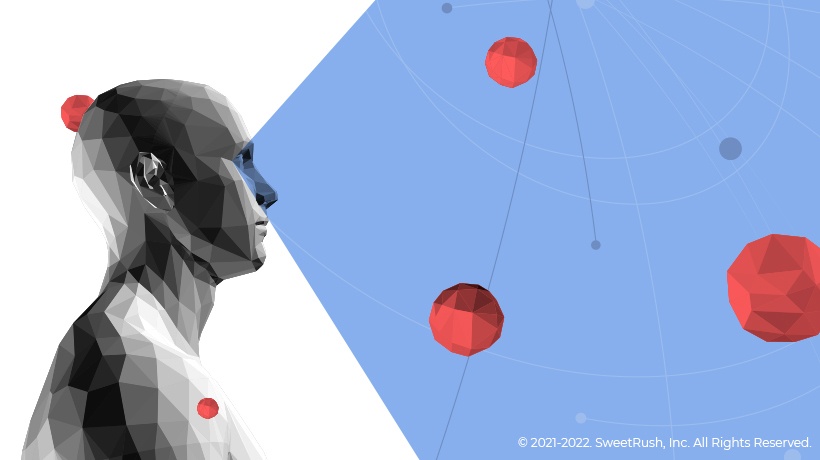Exploring Immersive Learning Technology And Corporate Culture-Building With Tiffany Vojnovski
Tiffany Vojnovski is a learning enthusiast who has over 15 years of experience as an Instructional Designer for K-12, corporate, and nonprofit organizations. As an eLearning Evangelist for SweetRush, Tiffany uses her L&D expertise and experience to create innovative solutions that make the corporate workplace a better place. She also shares her valuable insights on learning and technology in her eLearning Industry articles. Today she shares her insights with us on cultivating talent and breaking down the fourth wall in L&D.
Many articles that you’ve published on eLearning Industry focus on human-centered design and connecting with learners on a deeper level. In your opinion, what’s one of the most common (and avoidable) faux pas that you see organizations make when it comes to creating learning experiences for the individual?
One of the biggest faux pas L&D professionals face is what I call “maker’s bias”—the bias towards making a thing, anything, even if it’s not necessary or desirable. We’re at risk of maker’s bias anytime we fulfill training requests driven by factors other than a true business and learning need.
Maker’s bias often results from the very real pressure to prove the value of the L&D function within our organizations or to our clients. Our value-adds tend to be nuanced and behind-the-scenes: for example, being consultative, advocating for learners, or leveling with a business partner who has the budget to burn but no learning need. These are wonderful qualities to bring to the table, and our partners reward us with their trust and loyalty.
Still, what gets rewarded in many organizations is building a thing—especially a big, shiny, never-seen-before thing. The same goes for our business partners, who themselves are under pressure to produce and show results. So they make their shiny, never-seen-before learning program mandatory to ensure a high completion rate and justify their training budget. The requirements then trickle down to learners, who don’t see what’s in it for them.
There’s another faux pas: forgetting about internal marketing. A learning solution may beautifully address both a business and a learning need, but if it’s not communicated in a way that is relatable and motivating, learners won’t bite. They might click through—after all, it’s mandatory!—but if they detect any corporatespeak or filler, they’ll tune out. Lead with the WIIFM: what do learners want, and how can this learning program help them get it?
Sometimes, amid the pressure to build, we forget to ask these questions—or worse, ask them too late. We can avoid these risks by involving learners early, at the needs analysis stage. Learners are typically quite aware of their triumphs, pain points, and needs—and happy to be asked about them. Engaging them early—and staying in touch—can help us break out of maker’s bias and grow a team of credible, vocal advocates for our programs.
Is there an eLearning client success story or past project that stands out in your mind, and why?
This one wasn’t my own solution; it was something I talked through with a colleague. She was responsible for training and managing a team of call center associates who—on paper, at least—were performing poorly.
Her team members were receiving low satisfaction scores from customers, who complained that they were “rude” or too direct—think, “What do you want me to do?” versus, “What can I help you with?” Even when they followed the script, customers didn’t rate them as genuinely caring about their needs.
Meanwhile, my colleague was being pressured by her supervisors to improve customer satisfaction scores—and quickly. She was at her wit’s end with her team: they had signed off on the employee manual; they had taken the customer service training; what was their problem?
Her frustrations were causing her to view her team from a deficit perspective: she saw only how different the employees she had were from the ones she wanted. After we talked through the frustration, we talked about the reality: people rarely want to mess up. If they do mess up, it’s usually because they’re missing critical information or perspective. It doesn’t help much to talk about what we think they should know or be able to do. They need instruction—and a WIIFM.
After a deep conversation and a deeper breath, my colleague and I started sketching out a new kind of associate training. Instead of scripts and handbook chapters, we sketched out modules that approached customer service as a foreign language—complete with its own phrases, tenses, and norms. We worked through a unit explicitly teaching phrases and sentence starters for initiating each part of a call and clarifying customers’ needs. It was all about attaining fluency—not “good” or “bad” service.
It was a fun learning journey; I really wish it was mine! But the main takeaway for me was the value of getting a fresh perspective on L&D challenges—and meeting our peers with curiosity, not judgment.
Can you offer any words of advice to help L&D teams become more resilient and forge a communicative culture?
This one is for any team leader who, secretly or not, believes they have an A team and a B team: hierarchy is exhausting and it hurts everyone. Clients resent being stuck with the B team, your B team resents being undervalued, and your A team resents always being called on.
Instead, try growing the team members who haven’t had a chance to show their strengths. For example, if someone’s presentation style needs work, have them shadow a stronger peer. An inside look at how a strong presenter thinks, prepares materials, and practices their delivery will help them understand the work that should go into a presentation. Assign them small portions of lower-stakes presentations until they gain the skills they need to move off the bench.
Your stars can also learn from their peers. Underutilized team members are often great at tasks that are less visible—but no less vital. They’re often the ones running the numbers or providing the tech support behind the scenes while your stars are in the limelight. And they’ve got plenty of wisdom about how the show gets pulled off and what’s possible—things your A team may be less in touch with.
Individual contributors: if you feel this dynamic on your team, reach out to an undervalued colleague. If you usually hand off projects to them, involve them earlier in the development process. Adopt a mindset of brainstorming with them rather than sending to them. Having more context about the project history, goals, and client relationship sets them up for more success at the next step of the project. When you figure out what makes them indispensable, find opportunities to credit them in front of other team members—and clients.
If you’re feeling like the undervalued one, approach a star and ask them to teach you one of their skills. It takes little extra preparation to screen-share and talk through a task or add you on listen-only mode as they pitch a client. Most L&D folks enjoy sharing knowledge and would be honored to be asked!
If you could gaze into an eLearning crystal ball, what do you think the future holds for remote L&D, especially regarding the use of emerging learning tech?
We’ve all been conducting so much of our lives through screens that I think we’re craving learning solutions that break down the fourth wall. It’s the ultimate paradox: breaking through the screen…by means of a screen. A great movie or series can achieve that, but how can remote learning achieve that level of engagement?
It helps when learning moves with us and doesn’t tether us to a glowing square on our desks. I’ve gotten really interested in Extended Reality solutions that allow learners to move around through an enhanced version of their physical environment, or even a digital twin, and practice tasks and skills.
Those might be Augmented Reality (AR) digital tutorials tagged to fixed points in learners’ physical environment, a la Pokémon GO, that pop up to walk them through a process or piece of machinery. Or they might take the form of an entirely immersive Virtual Reality (VR) environment where learners can practice performing high-stakes tasks like surgery—and skills we hope they’ll never have to use, like hazardous waste spills and natural disasters.
With a shared virtual meeting space, we can even get back to the live learning experiences so many learners have been missing. I’m really excited about a new modality my friends on the SweetRush Immersive Learning team have devised: the VR-ILT, or Virtual Reality Instructor-Led Training. It brings learners together in a virtual space for a synchronous experience led by an instructor who can then guide learners in practicing new skills and tweak variables in the environment to address every learner’s needs. For example, if I’d been able to take my boat operator’s safety course in VR-ILT when I was in seventh grade, I could have met my peers on a virtual boat—and practiced docking, piloting, and even rescue maneuvers live instead of reading about them in a manual. And the instructor could see exactly how each student was performing and increase the challenge or remediation accordingly. While the advanced students moved on to choppy waters, I could keep working on tying knots at the dock.
Imagine the benefits of VR-ILT for surgery, emergency responses—any procedure for which competence means the difference between life and death. The VR-ILT not only breaks the fourth wall with its immediacy; it’s also the perfect answer to the dilemma of needing experience to gain experience. I can’t wait to see where we take it!
Wrapping Up
Tiffany, we truly appreciate you taking the time to chat with us and for always being ready and willing to share your insider know-how with the community.
You can also find Tiffany Vojnovski on our eLearning Trailblazers: Presenters Who Engage And Enlighten list for her dedication to overcoming learning challenges and helping organizations pinpoint areas for improvement.






